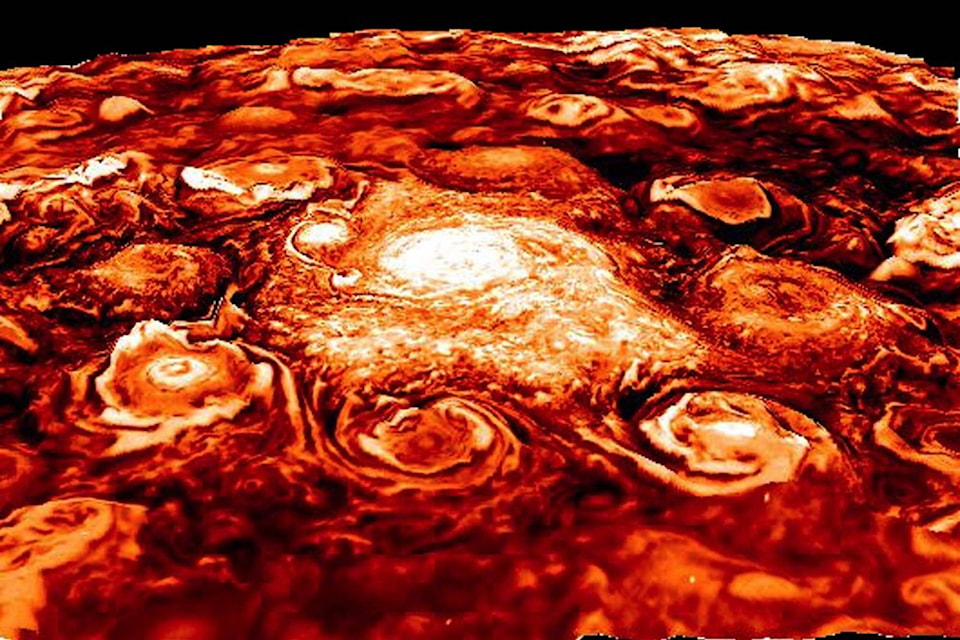As two Voyager spacecraft flew past Jupiter in 1979 on their way to the outer solar system they sent back images of enormous storms.
Now we are getting a better look. The Juno spacecraft is orbiting the giant planet and sending back the most amazing images.
Try browsing for “Jupiter polar storms.” One shows one of the planet’s poles. There is a huge storm, a polar vortex, encircled by several storms.
Other images show more storms, some of them standing against the flow of the atmosphere, and forming turbulent wakes.
Then there is the Great Red Spot, a storm big enough to engulf the Earth, which has been raging for at least 300 years. What drives all this activity, and why is it so organized?
On Earth, the energy for the weather is provided by the sun and processed by our planet’s rotation and circulation of the atmosphere. If we were standing on the equator, that rotation would be carrying us eastwards at around 1,700 kilometres an hour.
However, if we were standing at the north or south pole, we would be moving at zero km/h, just turning around once a day.
At the hot equator, air arrives along the ground, warms and rises and moves toward the poles. At the poles the air cools and sinks, and moves back towards the equator.
This means air is constantly moving into places where it is faster than, or closer than the Earth’s rotation.
The collisions between masses of air moving at different speeds drive most of our weather. The situation is rendered more chaotic by the presence of large oceans and continental landmasses.
Things are different on Jupiter. Firstly, Jupiter is around 1,400 times the volume of the Earth but has only 318 times the Earth’s mass, which means Jupiter is mostly gas, although there might be a rocky body somewhere in the middle.
The atmosphere is very deep and has no underlying land or ocean to interfere.
Secondly, the Earth has a diameter of 12,756 km and rotates once every 24 hours, which translates to a rotation speed of 1,700 km/h at the equator. Jupiter has a diameter of 143,000 km and takes less than 10 hours to complete each rotation.
So the top of the atmosphere over the equator is moving at almost 43,000 km/h. As in the case of the Earth, the atmosphere over the poles is moving at 0 km/h.
This speed difference means that north-south motion of the atmosphere is more difficult, and the weather systems settle into east-west bands. Even a small telescope will show them.
The speed differences in- and between these bands drive lots of small storms—small by Jupiter’s standards. Some of them are bigger than the Earth. This band structure of the atmosphere helps form that regular ring of storms around the polar vortex.
One thing that is particularly intriguing about the weather on this giant world is that storms can stay fixed as the rest of the atmosphere flows past. The Great Red Spot is a particularly good example. It has not moved much since it was discovered.
Some suggested this is because it is driven by a huge volcano erupting under it. However, there is no volcano, just thousands or tens of thousands of kilometres of atmosphere.
There is a very interesting illustration in James Gleick’s book Chaos. It shows a rotating pan of coloured oils. After it had been run enough to settle down, bands of colour developed, as on Jupiter, and an eddy formed. The colours must have been picked with this in mind because that eddy is coloured red in the picture.
Once it formed, it stayed, rotating between adjacent bands.
This suggests that the Great Red Spot is not just a local feature, it is related to Jupiter’s global weather system. How is that?
Mars lies in the southwest after dark. Jupiter lies low in the south in the predawn sky, with Saturn to its left and Venus shining low in the dawn glow.
Ken Tapping is an astronomer with the National Research Council’s Dominion Radio Astrophysical Observatory.

